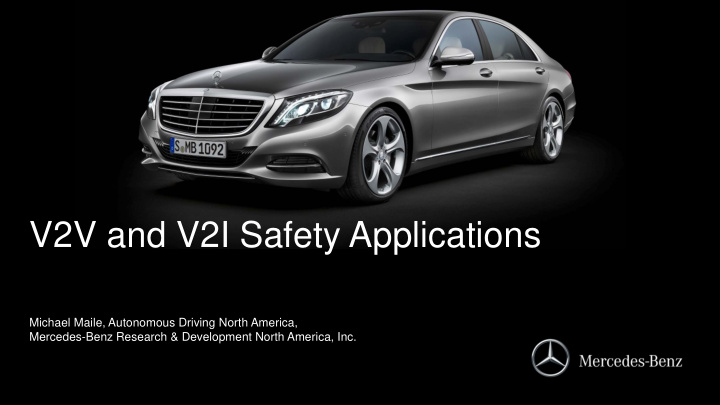



V2V and V2I Safety Applications Michael Maile, Autonomous Driving North America, Mercedes-Benz Research & Development North America, Inc.
Outline Vehicle Communications for Safety Applications • Vehicle – Vehicle Communications Safety Applications Examples • Vehicle – Infrastructure Communications Safety Application Examples Infrastructure Support for Autonomous Driving Implications for Future Infrastructure Outlook 2 Mercedes-Benz Research & Development North America, Inc. | Date
Motivation Vehicle communications has the potential to revolutionize traffic and traffic operations • Fewer accidents • Better signal timing and speed harmonization for improved traffic flow • Better information for DOTs for decision making • Improved operations But • Requires new equipment • RSEs, possible replacement of old signal controllers and/or protocols (170s, AB 3418) 3 Mercedes-Benz Research & Development North America, Inc.| Department | Date
Communication based safety applications Applications use 5.9GHz Dedicated Short Range Communication (DSRC) or mobile communications to communicate vehicle and infrastructure status information Two basic types: • Vehicle-Infrastructure communication (V2I) • Vehicle-Vehicle communication (V2V) Systems use absolute positioning and relative positioning • This includes differential corrections Maps are sent from the infrastructure to the vehicle Positioning based on GPS and dead reckoning 4 Mercedes-Benz Research & Development North America, Inc.| Department | Date
V2V communication based safety applications Information is transmitted between vehicles Enables vehicles to know where the vehicles in its vicinity are and what they are doing Applications include • Forward Collision Warning • Emergency Electronic Brake Light <Position> • Blind Spot/Lane Change Warning <Speed> <Heading> • Intersection Movement Assist <Yaw Rate> <Path History> • Do Not Pass Warning <Acceleration> <GPS corrections> • Control Loss Warning • Currently the applications are warning only, but could include braking later on 5 Mercedes-Benz Research & Development North America, Inc.| Department | Date
Basic Safety Message as per SAE J2735 BSM Part II BSM Part I Event Flags (EEBL, CLW) DE_DSRCMsgID Path History DE_MsgCount Path Prediction DE_TemporaryID RTCM DATA DE_Dsecond Exterior Lights DE_Latitude Wiper Status DE_Longitude Vehicle Height DE_Elevation Bumper Heights DF_PositionalAccuracy Throttle Position DF_TransmissionAndSpeed Speed Vehicle Type Transmission BSM Part I with every broadcast DE_Heading DE_SteeringWheelAngle DF_AccelerationSet4Way BSM Part II Path History and Path LongitudinalAcceleration Prediction with every broadcast LateralAcceleration VerticalAcceleration Part II Events as occuring Yaw DF_BrakeSystemStatus Other data as needed DF_VehicleSize 6 Mercedes-Benz Research & Development North America, Inc.| Department | Date
Where are we with this? • V2V was developed and tested successfully in the Model Deployment in Ann Arbor, MI • Nearly 3000 vehicles – cars, busses and trucks equipped with V2V communication technology • Mixture of fully integrated vehicles (64) and carry-in devices Possible NPRM in 2016 for the V2V communications technology Increasing number of connected vehicles on the road • Broadcasting and receiving information to and from vehicles and infrastructure • Large source of data • Is the BSM enough or do infrastructure operators need other information 7 Mercedes-Benz Research & Development North America, Inc.| Department | Date
V2I communication based safety applications Antennas Information is transmitted from the infrastructure to a vehicle Infrastructure uses Roadside Equipment (RSE) that includes a DSRC radio <Position> RSE Examples are <Signal Phase <Position> GPS and Timing> • Cooperative Intersection Collision Avoidance <Dynamic Info> <Local Map> Systems <Path History> <GPS Corrections> <Other probe data> • Road departure warning <Road Condition> <Security> <Weather> • Danger zones <Security> • Speed limits ACC Speed • Weather based hazards Roadside Information can contain a local map Equipment RSE CICAS application will be described in more detail 8 Mercedes-Benz Research & Development North America, Inc.| Department | Date
Infrastructure support for Autonomous Driving Traffic signal information Intersection maps and updates Stop sign and stop location information Recommended speed Position correction Lane closures Hazards/Construction sites Weather related information … 9 Mercedes-Benz Research & Development North America, Inc.| Department | Date
Some implications for future infrastructure Future Infrastructure needs to be networked, equipped with communications Infrastructure communications needs to be part of the overall security system The denser the network of RSEs, the more information about traffic can be gained Data analysis/data mining capabilities in TMCs There will be different communication channels for different applications • Mobile Communications • DSRC What are the data needs and how can they be satisfied 10 Mercedes-Benz Research & Development North America, Inc.| Department | Date
Outlook Upcoming USDOT/FHWA projects will address infrastructure • Safety • Mobility • Weather The projects will address application development and field tests Opportunity to promote CA cities as field test opportunities
Recommend
More recommend